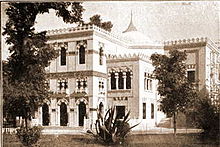Azbakeya
This articleneeds additional citations forverification.(February 2024) |

Azbakeya(Arabic:أزبكية;also spelledAl UzbakeyaorAuzbekiya[1][2][3]) is one of the districts of the Western Area ofCairo,Egypt.[4]Along withWust Albalad (Downtown)andAbdeen,Azbakiya forms Cairo's 19th century expansion outside themedieval city wallsknown officially as Khedival Cairo and declared as an Area of Value.[5][6]It holds many historically important buildings and spaces. One of these is theSaint Mark's Coptic Orthodox Cathedral,which was inaugurated byPope Mark VIIIin 1800[7]and served as the seat of thePope of the Coptic Orthodox Church of Alexandriafrom 1800 to 1971. Azbakeya was the place where thefirst Cairo Opera Housewas established, in 1869.
Administrative divisions and population
[edit]
In 2017, Azbakiya diatrict/qism had 19,763 residents in its eightshiakhas:[8][9]
| Nom | Code 2017 | Population totale |
|---|---|---|
| `Urâbî | 012007 | 2027 |
| Fajjâla, al- | 012004 | 2833 |
| Jayyâra, al- | 012001 | 837 |
| Klût Bây (Clot bey) | 012008 | 1522 |
| Qabîla, al- | 012005 | 4039 |
| Qulalî, al- | 012006 | 3439 |
| Rîḥânî, al- | 012002 | 953 |
| Zahhâr, al- | 012003 | 4113 |
History
[edit]
The district of Azbakeya was built upon a place of an oldCopticvillage,Tiandonias(Coptic:ϯⲁⲛⲧⲱⲛⲓⲁⲥ) orUmm Dunayn(Arabic:ام دنين) which was also calledal-Maks(Arabic:المكس"customs" ) in latter sources andOttomandocuments.[10][11]
By the time ofBarquq,the firstBurji Mamluk sultan(1382-1399), a lot of reconstruction needed to be done within the walls of the city to repair the damages incurred as a result of theBlack Death.In 1384, when Barquq started hismadrasainBayn al-Qasrayn,markets were rebuilt, andKhan al-Khalili,the most famous touristic market in Cairo, was established.
Al-Maqrizishowed that the northern cemetery, founded by al-Nasir Muhammad, contained no building at all before his third reign. When al-Nasir Muhammad in 1320 abandoned the area betweenBab al-Nasr cemeteryand theMuqattam,a small number of buildings started to be built in the northern cemetery.
Under the Burji Mamluks, northern cemetery became the new area targeted for the any new city expansion, since no ideological oppositions were found preventing the construction of dwelling within cemeteries. The lack of opposition allowed for the construction of striking religious buildings of monumental scale in the northern cemetery. Examples include theKhanqah of Faraj ibn Barquq,Madrasa of Al-Nasir Muhammad,theEmir Qurqumas Complex,theMosque-Madrasa of Sultan al-Ashraf Barsbayand theComplex of Sultan al-Ashraf Qaytbay.
During the latter half of the 15th century, two final major transformations took place in Cairo: the port ofBoulaq,and a district called Azbakeya in the northwest section of the city. The parameters of the city had been unchanged for the past 300 years according to the map done by the French expedition in 1798. WithBaibars's conquest ofCyprusin 1428, Bulaq became the major port of Cairo. By the end of the 15th century, Bulaq was even able to take over the role as the major commercial port fromOld Cairo.
The Azbakeya district was developed when Amir Azbak al-Yusufi, one of Qaytbay's princes, established stables and a residence of his own and excavated Birkat al-Azbakeya, which was fed from theCairo Citadel Aqueduct.With theArab's Gulfalways serving as the western boundary of the city and feeding nearby ponds, flooding would occur during the summer. After each flooding, surrounding lands would be transformed into lush green areas with vegetation. These beauty of the land in these areas were exquisite and the upper class fought over the each other for the first pick of the land to buy for the construction of their new palaces overlooking such bodies of water as Birkat al Fīl "Elephant Pond" and Azbakeya Pond.
Modern history
[edit]
TheEgyptian Museumwas established by the Egyptian government in 1835 near the Azbakeya Gardens.[12]The museum soon moved toBoulaqin 1858 because the original building was too small to hold all of the artifacts.
In the 1850s, the area was renovated during the rule ofIsma'il Pashain his plan to build a modern Cairo. Currently the well knownSoor Elazbakeya(meaning the fence of Azbakeya) is a used books market[13]that originated by a gathering of used books traders by the fence of the Azbakeya garden in 1926. (The market relocated to El Darasa in 1991 while a Metro station was being built, but returned to its original location in 1998).[14]

By the late 19th century, the area became a center of entertainment, with the openings of cafes, bars, gambling halls, hashish dens and at least thirteen large entertainment venues.[15]The Azbakeya gardens theater was the stage to most of the monthly concerts held by the famous Arab singer,Umm Kulthum.The Azbakeya gardens is only partially present now as two multi-story car parks have been built on large areas of the gardens.
References
[edit]- ^Guide to Palestine and Egypt.London: MacMillon and Co., Limited. 1901. pp.162-166.
- ^Sladen, Douglas (1911).Oriental Cairo: The City of the "Arabian Nights".Philadelphia: J. B. Lippincott Company. pp. xiii, 45, 54–63.ISBN9785877802247.
- ^"Crisis en Egipto: Más de 70 muertos en nuevo día de enfrentamientos"[Crisis in Egypt: More than 70 dead in a new day of fighting].La Segunda(in Spanish). Empresa El Mercurio SAP. August 16, 2013.RetrievedSeptember 11,2019.
- ^"Western Area".www.cairo.gov.eg.Retrieved2023-02-23.
- ^"Khedivial Cairo".egymonuments.gov.eg.Retrieved2023-03-26.
- ^Khedival Cairo protection boundaries(PDF)(in Arabic). Cairo: National Organistation for Urban Harmony. 2022.
- ^"shababchristian".Archived fromthe originalon 2007-09-28.Retrieved2008-02-24.
- ^Central Agency for Public Mobilisation and Statistics (CAPMAS) (2017)."2017 Census for Population and Housing Conditions".CEDEJ-CAPMAS.Retrieved2023-02-21.
- ^The interactive census site is the only available source with data at the shiakha level and must be queried as follows: Statistics and analysis > Population > 2017 Data > Gender >Statistical Tables >Total population and population by sex by shiyâkha/qarya > Choose location.
- ^Gabra, Gawdat; Takla, Hany N. (2017).Christianity and Monasticism in Northern Egypt: Beni Suef, Giza, Cairo, and the Nile Delta.Oxford University Press.ISBN978-977-416-777-5.
- ^Amelineau, Emile (1980).La Géographie de l'Egypte À l'Époque Copte.Paris. p. 491.
{{cite book}}:CS1 maint: location missing publisher (link) - ^Johnson-Roehr, S. N. (11 August 2023)."Making Egypt's Museums".JSTOR Daily.
- ^10 bestArchivedDecember 29, 2007, at theWayback Machine
- ^"Street Smart: Souq El Azbakeya, a haven for book lovers".Ahram Online.
- ^Cormack, Raphael (2021-05-06). "Chapter 1".Midnight In Cairo: The Female Stars of Egypt's Roaring '20s.Saqi Books.ISBN978-0-86356-338-6.


